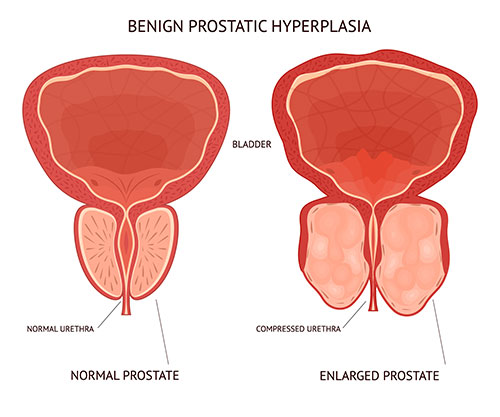Prostate Artery Embolization
The Interventional Radiologists at MRA specialize in Prostate Artery Embolization, a cutting-edge, non-surgical treatment for benign prostatic hypertrophy.

What is benign prostatic hyperplasia (BPH)?
Benign prostate hyperplasia (BPH) is a common condition as men get older. An enlarged prostate gland causes blockage of normal urine flow, causing frequent urination, urination at night, difficulty starting urination, weak urinary stream, or inability to completely empty the bladder. Occasionally, it can also cause infection or blood in the urine. Symptoms tend to worsen over time.
Typically, your primary health care provider will first assess your symptoms and perform a physical exam. If these suggest that BPH is possible, a Urologist may perform urine flow studies and/or imaging to confirm the diagnosis.
BPH is often first treated with medications which can relax the muscles near the prostate or cause it to shrink. If your symptoms persist or are moderate-severe, your Urologist may recommend a surgical procedure in which a part of the prostate gland is removed. You or your Urologist may also want to consider Prostate Artery Embolization as an alternative to surgery.
Prostate artery embolization (PAE) is a minimally invasive treatment which is a highly effective and safe alternative to surgery. PAE begins by inserting a catheter (a thin, flexible tube) into a blood vessel in the groin. Using real-time imaging guidance, it is navigated to the arteries supplying the prostate gland. Once the catheter is in position, tiny particles are injected which block the blood supply to the gland, causing it to shrink. It is performed through an incision in the skin the size of a pencil tip. Patients typically go home the same day. Following the procedure, the gland will decrease in size roughly 20-40% over the next few weeks/months. This allows urine to continue flowing normally again.
A growing body of evidence shows that PAE is just as effective in treating BPH as surgery. Large studies have shown that 75-80% of men who undergo the procedure have satisfactory improvement in their symptoms. The results last for at least 6 years but could last much longer. Moreover, patients who underwent PAE had a lower risk of sexual dysfunction than patients who underwent surgery.
PAE is typically covered by insurance. Your out-of-pocket expense will depend on your specific insurance plan.
Request a consultation today:
One of our expert Interventional Radiologists will personally review your imaging and case with you, and discuss whether Prostate Artery Embolization is the right option for you.
Patients, please note that services may require a referral from your primary care or another provider, but we can help facilitate that process if treatment is deemed necessary. Telehealth consultations may be available depending on the type of procedure required.

